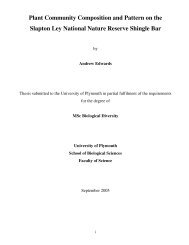de Vere 2007 Biol Flora C. dissectum.pdf - The Whitley Wildlife ...
de Vere 2007 Biol Flora C. dissectum.pdf - The Whitley Wildlife ...
de Vere 2007 Biol Flora C. dissectum.pdf - The Whitley Wildlife ...
- No tags were found...
You also want an ePaper? Increase the reach of your titles
YUMPU automatically turns print PDFs into web optimized ePapers that Google loves.
892N. <strong>de</strong> <strong>Vere</strong>© <strong>2007</strong> <strong>The</strong> AuthorJournal compilation© <strong>2007</strong> BritishEcological Society,Journal of Ecology,95, 876–894Weeda 2000; Jongejans 2004; van <strong>de</strong>n Berg et al. 2005).Soons et al. (2005) related seed dispersal ability tothe availability of suitable habitat within an area of theNetherlands to investigate habitat connectivity. <strong>The</strong>remaining grasslands containing C. <strong>dissectum</strong> werefound to be practically isolated from each other interms of seed dispersal with the regional survival of thespecies being completely <strong>de</strong>pen<strong>de</strong>nt on a few largepopulations in nature reserves. Due to these factors,C. <strong>dissectum</strong> is now on the Dutch Red List of endangeredspecies (Rossenaar & Groen 2003; Jongejans et al. 2006a).Research has been conducted in the Netherlands(Berendse et al. 1992; Jansen & Roelofs 1996; Jansenet al. 1996; Beltman et al. 2001) and the UK (Tallowin& Smith 2001) into the best methods for restoringCirsio-Molinietum fen meadows. Topsoil removal to<strong>de</strong>crease soil fertility in areas with a suitable hydrologicalregime has proved to be the most successful approach.<strong>The</strong> UK Biodiversity Action Plan lists purple moorgrass and rush pasture as a priority habitat with plansto recreate this habitat on land adjacent to or nearbyexisting sites (HMSO 1995) and van Soest (2001) has<strong>de</strong>veloped a methodology for the i<strong>de</strong>ntification ofsuitable restoration sites in south-west England.Smul<strong>de</strong>rs et al. (2000) used AFLP to investigategenetic diversity between source and reintroducedpopulations of C. <strong>dissectum</strong> in the Netherlands. Sourcepopulations showed small but significant geneticdifferences (Φ ST 0.108). <strong>The</strong> first generation of reintroducedplants showed less genetic variation than theirsource populations and were also genetically differentiated,but assignment tests showed that reintroducedpopulations still resembled their source populations.Calculations showed that reintroduction from morethan one source population introduced significantlymore genetic variation and Smul<strong>de</strong>rs et al. (2000)suggested that this might be the best strategy for plantsin the Netherlands. Only a small number of populationswas studied, however, with a maximum distance betweenthem of 200 km. <strong>de</strong> <strong>Vere</strong> (<strong>2007</strong>) found greater levels ofdifferentiation between populations in the British Isles(G ST 0.276).AcknowledgementsMany thanks are due to Anthony Davy, Chris Preston,Michael Proctor, David Streeter, Eelke Jongejans,Eirene Williams, John Ross and Amy Plowman forvaluable comments on earlier versions of this manuscript.Colin Ford’s help with fieldwork ma<strong>de</strong> this projectpossible. David Roy (CEH) kindly provi<strong>de</strong>d informationfrom the Phytophagous Insects Database, Kevin Walkerupdated the published information on the hybrids ofC. <strong>dissectum</strong>, Chris Woolley helped with insect i<strong>de</strong>ntificationand Franziska Schrodt translated texts fromGerman into English. Ian Turner provi<strong>de</strong>d glasshousefacilities and horticultural advice and Wayne Edwards,Ann Chapman, Sarah Cunningham and Maxine Chavnerassisted with germination trials and growing plants. Ithank the vice-county recor<strong>de</strong>rs of the BotanicalSociety of the British Isles and Devon <strong>Wildlife</strong> Trust forhelping i<strong>de</strong>ntify Cirsium <strong>dissectum</strong> sites and the librarystaff of the Royal Botanic Gar<strong>de</strong>ns, Kew, for help withthe literature.ReferencesAllen, S.E., Grimshaw, H.M., Parkinson, J.A. & Quarmby, C.(1989) Chemical Analysis of Ecological Materials, 2nd edn.Blackwell Scientific Publications, Oxford, UK.Beltman, B., van <strong>de</strong>n Broek, T., Barendregt, A., Bootsma,M.C. & Grootjans, A.P. (2001) Rehabilitation of acidifiedand eutrophied fens in <strong>The</strong> Netherlands: effects of hydrologicalmanipulation and liming. Ecological Engineering, 17, 21–31.Berendse, F., Oomes, M.J.M., Altena, H.J. & Elberse, W.Th(1992) Experiments on the restoration of species-richmeadows in the Netherlands. <strong>Biol</strong>ogical Conservation, 62,59–65.van <strong>de</strong>n Berg, L.J.L., Dorland, E., Vergeer, P., Hart, M.A.C.,Bobbink, R. & Roelofs, J.G.M. (2005) Decline of acidsensitiveplant species in heathland can be attributed toammonium toxicity in combination with low pH. NewPhytologist, 166, 551–546.Blackstock, T.H., Stevens, D.P., Stevens, P.A., Mockridge, C.P.& Yeo, M.J.M. (1998) Edaphic relationships among Cirsio-Molinietum and related wet grassland communities inlowland Wales. Journal of Vegetation Science, 9, 431–444.<strong>de</strong> Bolòs, O. & Vigo, J. (1995) <strong>Flora</strong> <strong>de</strong>ls Països Catalans III.Pirolàcies-Compostes. Editorial Barcino, Barcelona,Spain.Bonnier, G. (1851–1922) Flore Complète Illustrée en Couleurs<strong>de</strong> France, Suisse et Belgique: (Comprenant la Plupart <strong>de</strong>sPlantes d’Europe). Delachaux et Niestle, Neuchâtel,Switzerland.Borsje, H.J. (2005) A Swallowtail Population at ShapwickHeath? Preliminary Study on the Feasibility by ComparingHost Plant Properties in Norfolk and Somerset. EnglishNature Research Reports, Number 631. English Nature,Peterborough, UK.Buck-Sorlin, G. (1993) Ausbreitung und Rückgang <strong>de</strong>rEnglischen Kratzdistel – Cirsium <strong>dissectum</strong> (L.) Hill inNordwest<strong>de</strong>utschland. Tuexenia, 13, 183–191.Buck-Sorlin, G. & Weeda, E.J. (2000) Oecologie en plantensociologischepositie van Cirsium <strong>dissectum</strong> (L.) Hill inOostfriesland. Stratiotes, 21, 1–10.Cheffings, C.M. & Farrell, L. (eds), Dines, T.D., Jones, R.A.,Leach, S.J., Mckean, D.R., Pearman, D.A., Preston, C.D.,Rumsey, F.J., Taylor, I. (2005) <strong>The</strong> vascular plant Red DataList for Great Britain. Species Status, 7, 1–116. JointNature Conservation Committee, Peterborough.D’Arcy, G. & Hayward, J. (1997) <strong>The</strong> Natural History of theBurren. Immel Publishing, London, UK.Dorland, E., Bobbink, J.H., Messelink, J.H. & Verhoeven,J.T.A. (2003) Soil ammonium accumulation after sod cuttinghampers the restoration of <strong>de</strong>gra<strong>de</strong>d wet heathlands.Journal of Applied Ecology, 40, 804–814.Durrance, E. & Lamming, D.J.C. (1982) <strong>The</strong> Geology ofDevon. University of Exeter, Exeter, UK.Ellenberg, H. (1988) Vegetation Ecology of Central Europe.Cambridge University Press, Cambridge, UK.Ellis, M.B. & Ellis, J.P. (1985) Microfungi on Land Plants.Croom-Helm, London, UK.Fiori, A. (1969) Nuora <strong>Flora</strong> Analitica d’italia. Edagricole,Bologna, Italy.Fojt, W. & Harding, M. (1995) 30 years of change in thevegetation communities of 3 valley mires in Suffolk,England. Journal of Applied Ecology, 32, 561–577.




